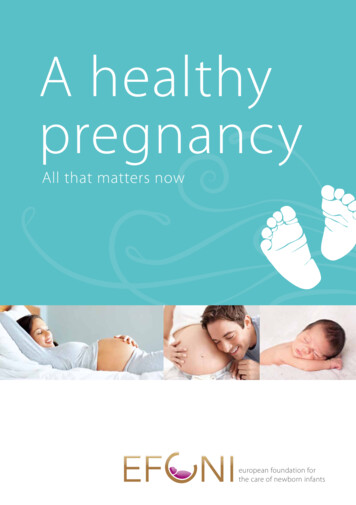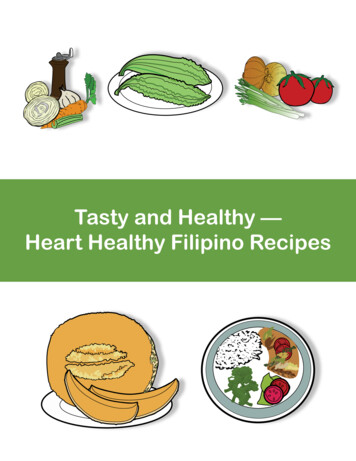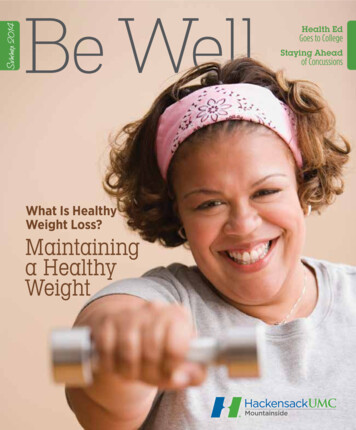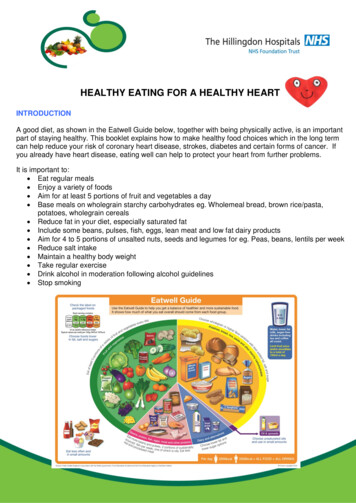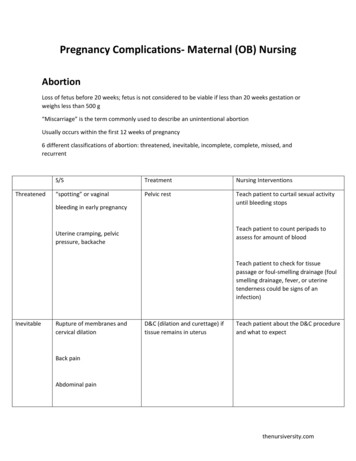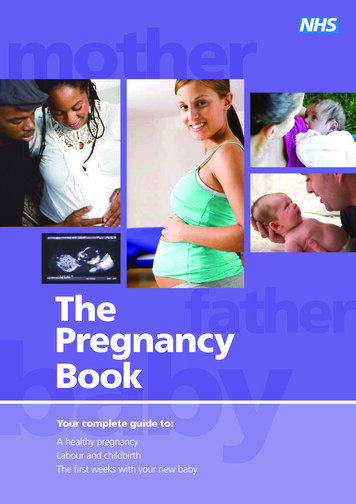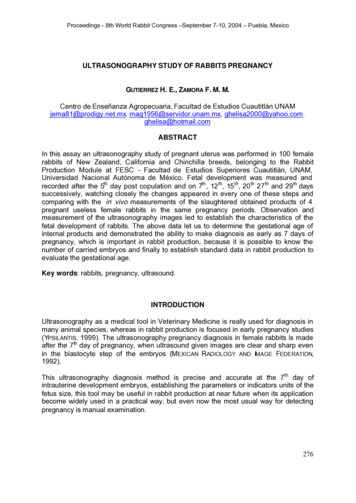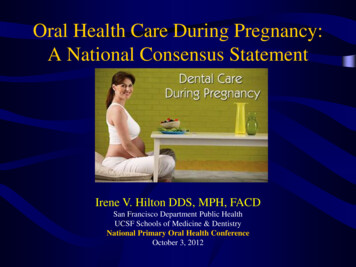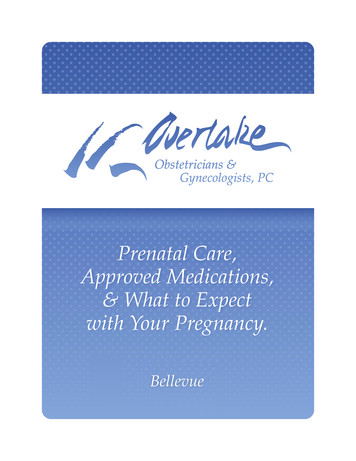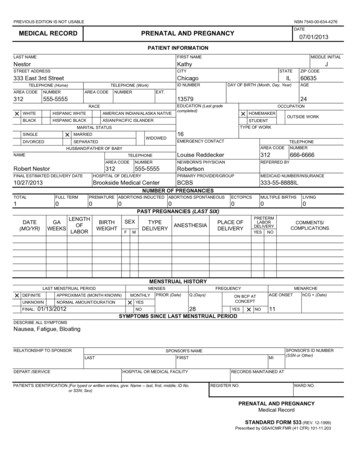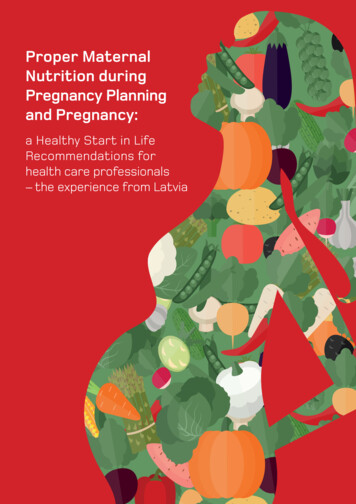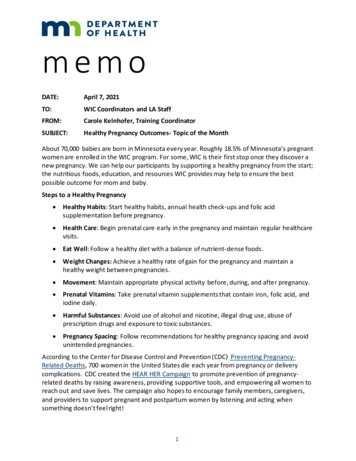
Transcription
memoDATE:April 7, 2021TO:WIC Coordinators and LA StaffFROM:Carole Kelnhofer, Training CoordinatorSUBJECT:Healthy Pregnancy Outcomes- Topic of the MonthAbout 70,000 babies are born in Minnesota every year. Roughly 18.5% of Minnesota’s pregnantwomen are enrolled in the WIC program. For some, WIC is their first stop once they discover anew pregnancy. We can help our participants by supporting a healthy pregnancy from the start;the nutritious foods, education, and resources WIC provides may help to ensure the bestpossible outcome for mom and baby.Steps to a Healthy Pregnancy Healthy Habits: Start healthy habits, annual health check-ups and folic acidsupplementation before pregnancy. Health Care: Begin prenatal care early in the pregnancy and maintain regular healthcarevisits. Eat Well: Follow a healthy diet with a balance of nutrient-dense foods. Weight Changes: Achieve a healthy rate of gain for the pregnancy and maintain ahealthy weight between pregnancies. Movement: Maintain appropriate physical activity before, during, and after pregnancy. Prenatal Vitamins: Take prenatal vitamin supplements that contain iron, folic acid, andiodine daily. Harmful Substances: Avoid use of alcohol and nicotine, illegal drug use, abuse ofprescription drugs and exposure to toxic substances. Pregnancy Spacing: Follow recommendations for healthy pregnancy spacing and avoidunintended pregnancies.According to the Center for Disease Control and Prevention (CDC) Preventing PregnancyRelated Deaths, 700 women in the United States die each year from pregnancy or deliverycomplications. CDC created the HEAR HER Campaign to promote prevention of pregnancyrelated deaths by raising awareness, providing supportive tools, and empowering all women toreach out and save lives. The campaign also hopes to encourage family members, caregivers,and providers to support pregnant and postpartum women by listening and acting whensomething doesn’t feel right!1
Risk Factors for Poor Pregnancy Outcomes Existing Health Conditions: Hypertension, diabetes, obesity, HIV/AIDs, and heart,thyroid, or kidney disease. Age: Teen pregnancy or first-time pregnancy over age 35. Race: Black and Indigenous women have 2-3 times the increased risk of pregnancyrelated mortality. Lifestyle Factors: Lack of a healthy diet and exercise, low income, and alcohol, tobacco,or drug use. Condition of Pregnancy: Gestational diabetes, pre-eclampsia, multiple gestation,previous birth complications, birth defects or genetic conditions. Healthcare: Lack of adequate and consistent healthcare services before, during, andafter pregnancy.Healthy People 2030, Pregnancy and Childbirth included 19 baseline objectives for pregnancyand childbirth. The goal is to prevent pregnancy related complications and maternal deaths andhelp women stay healthy through pregnancy into the postpartum period. The 19 objectivesinclude strategies to help all women develop healthy habits and encourage regular medical careduring their life span. Women in the United States have a greater risk of maternal death whencompared to other high-income countries. Intervention is essential in reducing healthdisparities, ensuring health equity, and improving the overall health and well-being of allwomen.The Dietary Guideline for Americans 2020-2025 (DGAs) dedicated Chapter 5 to women that arepregnant or lactating. By recognizing the importance of nutrition in pregnancy outcomes, theDGAs have highlighted specific dietary patterns and key nutrients to support infant growth anddevelopment and to maintain the mother’s health. Special consideration is also given to ahealthy weight status throughout the various stages of a woman’s life. The DGAs furthersupport healthy eating with referrals to programs such as the Supplemental Nutrition Program(SNAP), the Food Distribution Program on Indian Reservations (FDPIR), and Women, Infants &Children (WIC).Pregnancy and COVID-19The American College of Obstetricians and Gynecologists (ACOG), Novel Coronavirus 2019(COVID 19) reading provided an update finding that pregnant women who are symptomaticwith COVID-19 are at an increased risk of more severe complications. The CDC article, AssessingRisk Factors for Severe COVID-19 Illness, also placed pregnant women in an “increased risk”category for COVID-19. Pregnant women with “other risk factors” may be at an even greaterrisk.Educating pregnant participants on COVID-19 precautions should include following the adviceof their health care provider. Encourage participants to have a plan in case they are exposed tothe virus; discuss how they will access healthy foods, prenatal vitamins, and medications asneeded. WIC benefits are currently loaded onto their card remotely; participants may beencouraged to designate a proxy that could shop for them if needed.2
If a participant calls WIC and needs help, be sure you know the available resources your countyhas to offer so you may quickly get them to the right support services.Pregnancy and the COVID-19 VaccineThe CDC article, Information about COVID-19 Vaccines for People who are Pregnancy orBreastfeeding, reported that limited data is available about the safety of vaccination againstCOVID-19 during pregnancy. Recommendations continue to include having a discussion withone’s healthcare provider to determine the benefits and risks for each individual.WIC can make a difference!Numerous studies have shown that participation in WIC is associated with longer gestations,higher birth rates, and healthier infants. Supporting WIC participants begins with understandingtheir individual needs. Why 1,000 Days highlights the first 1,000 days as a window ofopportunity; it includes a woman’s pregnancy and goes until the second year of life. We canhelp support a healthy pregnancy outcome with encouraging both parents to build a healthyattachment to the developing fetus from the start.Things to consider: Explore the participant’s feelings about pregnancy and changes to the body. Assess stressors that can affect the pregnancy; does the participant have a safe place tostay, access to healthy foods, adequate medical care, and social support. Encourage healthy habits for the pregnancy and explore thoughts on how baby isdeveloping at different stages. Encourage both parents to connect with the fetus; read to, talk to, and touch the belly. Explore referrals/resources for access to services as appropriate, based on anindividualized need. Read notes/alerts from last appointment; follow up on any concerns that may havebeen discussed in the past.By using PCS Counseling Skills, we are better able to tailor education and referrals. Stayinginformed will aid in your ability to provide the most accurate and up to date information toparticipants. Staff may also use tools developed specifically to hone their skills in counselingand educating pregnant women.Tools to Review: Training Tool for Pregnant Woman Assessment Questions Maternal/Child/Infant Nutrition Modules- Maternal Nutrition Modules. Nutrition Information- English- Pregnancy, Breastfeeding, and General NutritionEducation cards.IMPORTANT: Early and adequate access to healthcare matters! Any woman who discovers theyare pregnant or wishes to become pregnant should be encouraged to seek out the care of ahealthcare professional who can monitor their health status before, during, and afterpregnancy.3
Staff Training SuggestionGroup ActivityReview: Read through the list of Healthy People 2030, Pregnancy and Childbirth 19 baselineobjectives.Discuss: Break into small groups and pick one objective each to discuss the impact WIC has onworking to meet this goal. Click to open the objective and read through the “Summary”. Consider the ways that education and counseling can help to support meeting the goal. Consider the resources WIC may share to offer additional support to parents.Share: Return to the larger group and share the chosen objective and summarize the groupdiscussion.No group, No problemReview: Read through the list of Healthy People 2030, Pregnancy and Childbirth 19 baselineobjectives.Choose: Pick a 2-3 of the baseline objectives. Click to open the objective and read through the“Summary”. Consider the ways that education and counseling can help to support meeting the goal. Consider the resources WIC may share to offer additional support to parents.Share: Contact a co-worker or friend to discuss the chosen objectives and any thoughtsgenerated.Please continue to send training topic suggestions and feedback to Carole Kelnhofer atcarole.kelnhofer@state.mn.us.Reference - Complete Listing of HyperlinksPreventing Pregnancy- Related Deaths EAR HER Campaign (https://www.cdc.gov/hearher/index.html)Pregnancy and Childbirth ary Guideline for Americans default/files/202012/Dietary Guidelines for Americans 2020-2025.pdf)Supplemental Nutrition Program (SNAP) upplementalnutrition-assistance-program.jsp)4
Food Distribution Program on Indian Reservations bution-program-indian-reservations)Women, Infant & Child (WIC) .html)Novel Coronavirus 2019 (COVID 19) -2019)Assessing Risk Factors for Severe COVID-19 .html)Information about COVID-19 vaccines for People who are Pregnancy or -ncov/vaccines/recommendations/pregnancy.html)Why 1,000 Days (https://thousanddays.org/why-1000-days/)PCS Counseling ining Tools for Pregnant Woman Assessment t.pdf)Maternal/Child/Infant Nutrition maternal)Nutrition Information - nutrition/morenutinfo.html)Pregnancy and Childbirth esota Department of Health - WIC Program 85 E 7th Place, PO BOX 64882, ST PAUL MN 55164-0882;651-201-4444, wic.health@state.mn.us, www.health.state.mn.us; To obtain this information in a differentformat, call: 651-201-44445
Risk Factors for Severe COVID19 Illness- , also placed pregnant women in an “increased risk” category for COVID- 19. Pregnant women with “other risk factors ” may be at an even greater risk. Educating pregnant participants on COVID -19 precautions should include following the
